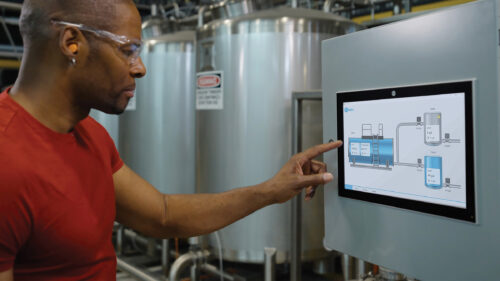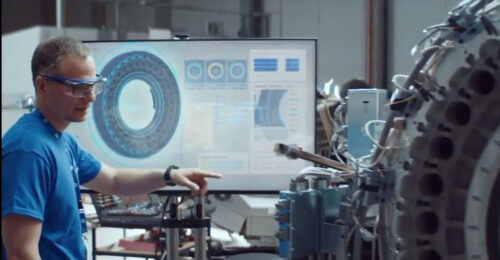Bit by bit: Why use serial communications?
In this day and age, why use serial communications, such as RS-232, RS-422, and RS-485? Digital industrial networks, fieldbuses, device- and sensor- level networks (also USB) all support many vendors’ products and can offer advanced features for configuration and diagnostics. So why use serial? Answers are low cost, simplicity, and familiarity.
| Hybrid communication modules, such as the Moor Industries International microNCS, include serial (Modbus-RTU and RS-485), Ethernet, and I/O connections. |
In this day and age, why use serial communications, such as RS-232, RS-422, and RS-485? Digital industrial networks, fieldbuses, device- and sensor- level networks (also USB) all support many vendors’ products and can offer advanced features for configuration and diagnostics. So why use serial? Answers are low cost, simplicity, and familiarity. Industrial serial communications, largely RS-232, RS-422, and RS-485, are still included on many products and machines because they provide simple, bit-level, point-to-point communications, and they are widely understood.
Serial communication still exists, says Jim Toepper, product manager for the connectivity group of Moxa Americas, because:
-
It remains an easy and inexpensive way to communicate with devices. Most vendors will offer a serial-only version as an entry-level product, offering an Ethernet-enabled version as a higher end offering;
-
If a product has been in production for many years and is proven, it could be cost- prohibitive for a device manufacturer to redesign and recertify an Ethernet (or other network-enabled) version of the same product. While Ethernet components themselves are not that much more expensive than serial components, implementation and design of Ethernet can be costly. “In some cases it is actually less expensive to buy an entry-level serial sensor or flowmeter and attach it to a serial-to-Ethernet converter to get your devices on the network,” he says.
-
In some cases, devices are coupled with a controller or data logger, sometimes in the same vicinity, thus negating the need for Ethernet. If the controller is central, and signals travel up to 4,000 ft, current loop RS-422 or RS-485 is preferred over Ethernet for flowmeters, temperature sensors, and similar devices. Many such devices use 4-20 mA, digital current loop, and Modbus over serial. Modbus can add some intelligence with timeouts and other capabilities.
“Serial can be the least expensive and simple solution when your communication is point to point,” Toepper says. Wider data sharing with other systems, or taking advantage of existing Ethernet, may call for a shift from serial devices or using a cost effective means of translation, he adds.
However, because serial communication transmits a bit of data at a time, it’s often not enough for many of today’s needs. High profitability and efficiency requires that the network: control the process; monitor the process, the communications efficiencies, and the calibrations of the process control sensors/actuators; catch alarms and trends; and then use that information to tweak the system for optimum performance, says Jim McConahay, senior field applications engineer for Moore Industries International Inc.
“We now realize that legacy protocols used on twisted pair cables are not able to accomplish this increased workload performance needed for maximum profitability/efficiency. There is just too much to do via traditional twisted pair, digital communications protocols,” McConahay says.
“Serial protocols are excellent for data transfer,” McConahay adds, “but do not conveniently enable increased information and control flexibilities.”
ONLINE EXTRA
Networks: Serial, digital, or both
Serial can be the least expensive and simple solution when your communication is point to point, says Jim Toepper, product manager – connectivity group, Moxa Americas.uipment using serial, Digital or Analog signaling there are many cost effective ways to Ethernet enable these devices without having to replace your devices altogether, Toepper says. www.moxa.com
Serial to digital translation tools
There are many translation tools to convert messages from one network to another. Here are a few.
-Hilscher Protocol Converter
www.hilscher.com/products_group_gateways.html
-HMS Industrial Networks (Anybus): Don’t rip out your legacy network
www.controleng.com/article/CA6602314.html
– Advantech: New generation of Modbus gateways, serial to Ethernet
www.controleng.com/article/CA6625412.html
Control Engineering Buyer’s Guide: Gateway Interfaces Suppliers
www.cesuppliersearch.com/us-product-51699.html
Related reading: Troubleshoot RS-485 networks
www.controleng.com/article/ca509767.html
| Author Information |
| Mark T. Hoske , Control Engineering editor in chief, is at MHoske@cfemedia.com . |
Serial network standards
Among other industrial network standards, Electrical Industry Alliance (EIA), offers:
RS-232: Interface for connecting serial devices. Many modems, display screens, and printers are designed to operate via an RS-232 port, typically up to 100 ft away.
RS-422: Based on the RS-232 standard, this is designed to support higher data rates and longer data transmission distances (up to 1.2 km), with greater immunity to electrical interference.
RS-485: Has as many transmission and immunity characteristics as RS-422, supports 2-wire multi-drop operation, and allows 32 RS-485 nodes over a 2-wire bus. The 2-wire RS-485 format is used widely for industrial control networks.
Once passed, the standards became EIA-232, etc., but widely retain their RS (recommended standard) first name.
Source: Control Engineering and Moxa.
Do you have experience and expertise with the topics mentioned in this content? You should consider contributing to our CFE Media editorial team and getting the recognition you and your company deserve. Click here to start this process.





